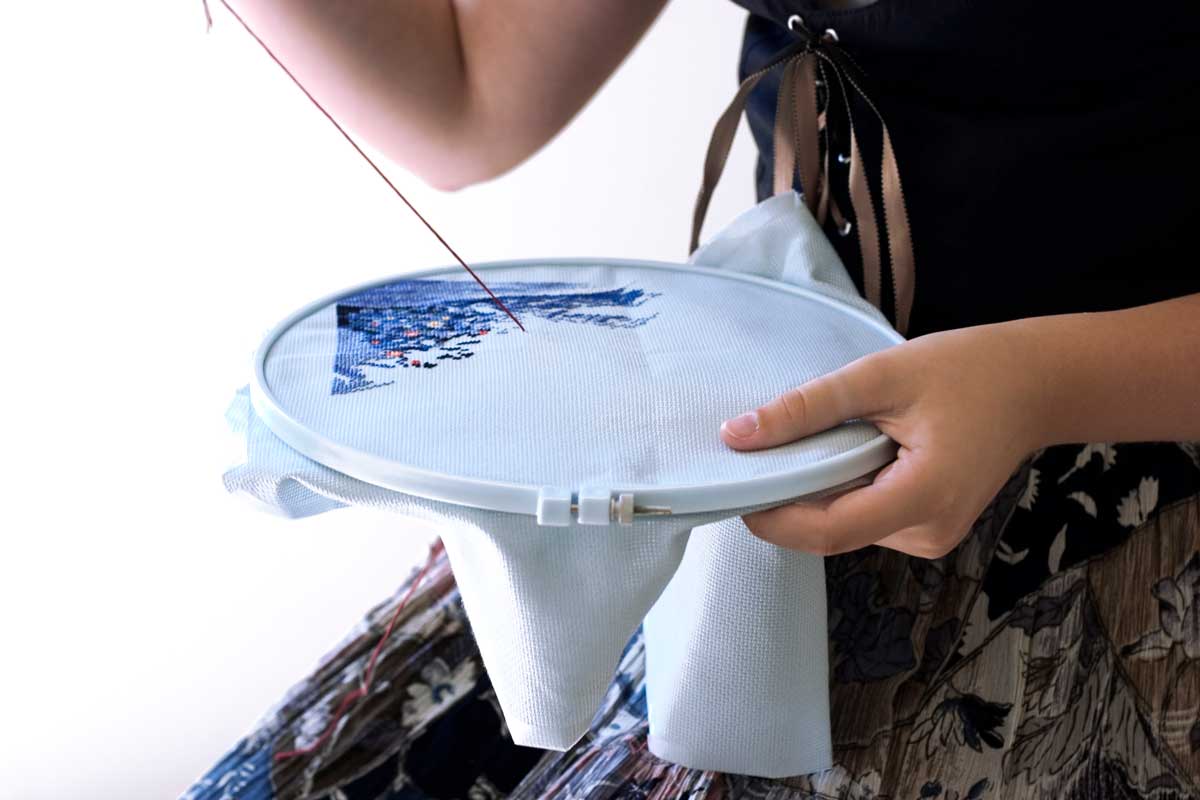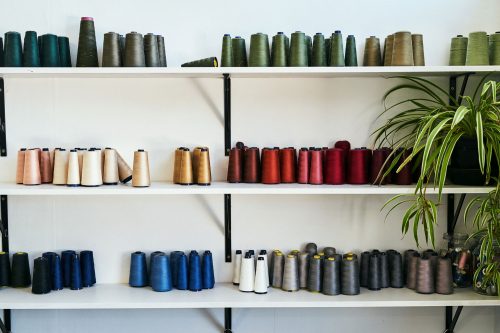Punch needle artwork is popular, rewarding, and relaxing. However, needle punching invites many different ideas and fabrics. You may be wondering if Aida cloth will be a viable foundation fabric. After all, punch needle artwork won’t hold together without the proper materials. So, it may be difficult to figure out how to get started, or even where to go next. But our thorough research has determined if Aida cloth is right for needle punching.
It is possible to use Aida cloth for needle punching, as long as you use Aida cloth that was made with a high fabric count. The process of needle punching requires tension to hold all of the loops in place. Unfortunately, Aida cloth offers many small counts that will not provide enough tension. It is essential to use Aida cloth with higher counts. You must also consider what material you are embroidering with.
It is important to fully understand Aida cloth before you use it for your next punch needle masterpiece. Otherwise, your hard work could literally fall apart! In fact, Aida cloth isn’t typically used for needle punching. As such, there is a lot more to consider. But your creativity is worth it. So, keep reading to learn if Aida cloth is best for your next project.

Using Aida Cloth
Aida cloth is a cotton foundation fabric that is traditionally used for cross-stitching. Aida cloth is ideal for cross-stitching because it is a stiff, even-weave fabric. The natural stiffness ensures that the fabric will remain taut without an embroidery hoop. The even-weave design allows for very accurate stitching.
Aida cloth is an even-weave fabric because the weft and warp threads are the same size, creating perfect squares. Weft and warp threads are essentially the rows and columns of the fabric. As such, the higher the fabric count, the finer the weave will be—similar to the resolution of a television screen.
So, if your heart is really set on using Aida cloth for your punch needle project, make sure it has a higher count. You'll experience much better results this way.
Is Aida Cloth The Same As Monks Cloth?
Monk’s cloth is an even-weave, loose material. It is also usually made of cotton, just like Aida cloth. The two materials are ultimately very similar. However, Monk’s cloth is generally considered more durable. Meanwhile, Aida cloth is known to fray rather easily.
This means that Aida cloth will require far more hemming. This could be necessary before you even begin stitching, which might be frustrating. Ultimately, it is commonly accepted that Aida cloth cannot hold yarn together as well as Monk’s cloth. Further, Monk’s cloth is widely known for its lightweight design. This makes it especially easy to work with.
Click here to see Monk's Cloth on Amazon.
What Are The Different Sizes Of Aida Cloth?
Aida cloth comes in a variety of different sizes, each determined by fabric count. The fabric count is ultimately determined by the number of open squares per inch. The fabric count also means the number of stitches per inch that the fabric will support.
Aida cloth sizes can be as low as 7-count, or as high as 28-count. There are several different increments between these numbers. This is a surprisingly wide range of options. You’ll want to experiment with what size can work best for your project. If you want to punch needle on Aida cloth, it is typically best to use a fabric count that is 14-count or higher.
Aside from the fabric count itself, it is possible to purchase pre-cut sheets of Aida cloth. These sheets are available in fairly large quantities, including 59-inch measurements.
Click here to find Aida cloth on Amazon.
What Floss Do You Use With Aida Cloth?
Yarn crafts can include a surprisingly large variety of materials. Even better, Aida cloth is available in many different sizes. Various fabric count sizes can accommodate different types of thread. Therefore, your choice of floss or thread is mainly determined by necessity or personal preference.
Embroidery floss is composed of six strands of thread, loosely twisted together. These threads are usually intended for separation. Embroidery floss is typically made of cotton, although it is also available in other materials. In fact, there are several types of useful embroidery floss.
Divisible Floss
Cotton floss is known for its dazzling sheen, softness, and durability. It can also be purchased in a variety of different colors. However, variegated floss offers softly multicolored threads. Satin floss is considered the shiniest possible thread, and it is composed of organic rayon fibers. Silk floss can shimmer fairly bright, too. Silk floss just happens to skew towards saturated colors.
Click here to find cotton floss on Amazon.
Non-Divisible Floss
Pearl cotton floss isn’t divisible at all. This is ideal for anyone that may be concerned about prep time when they are planning on stitching a new project. Further, pearl cotton floss is widely considered the most gorgeous thread on the market.
Metallic floss offers a metallic veneer to your thread. Bear in mind that metallic floss is typically made of polyester, which is renowned for its strength.
Click here to see pearl cotton on Amazon.
However, cotton floss ultimately remains the most versatile embroidery floss to work with. It is useful for general purposes and unique creations alike. Cotton floss also successfully balances quality and cost, making it ideal for everyday use.
Should You Wash Aida Cloth Before Stitching?
If you wash Aida cloth in hot water before you begin stitching, there will be a number of advantages and disadvantages. You may want to treat each embroidery project differently.
Cotton will shrink when it is washed. As such, pre-washing Aida cloth will ensure that you begin stitching with the true fabric sizing. This will also make the material more pliable. Unfortunately, it will also result in smaller holes. That can become very difficult to stitch on. This is especially true if the holes become less visible after washing the material.
If you wash Aida cloth in hot water, you will also remove its signature stiffness. This is because hot water will ultimately remove the cloth’s starch.
Stiff material is often considered easier to work with. That is a matter of personal preference. So, there are a number of opposing views on the subject. Those who use Aida cloth for traditional cross-stitching could find Aida cloth’s stiffness frustrating. However, stiffness could prove particularly useful for needle punching, which requires plenty of tension.
Why Is Aida Cloth So Stiff?
Aida cloth is stiff because of the starch. Starch is an organic compound that has been used to stiffen clothes since the 16th century. Originally, it was discovered that starch would capture sweat, dirt, and other grime. Starch actually seals Aida cloth’s fibers, protecting the material from stains. That is also why starch is a primary tool in dry cleaning.
Unfortunately, some modern manufacturers will use excessive amounts of starch on Aida cloth. This is because manufacturers can rely on excess starch to imitate genuine quality. After all, it is always best to purchase foundation fabrics of the highest quality.
In Closing

Aida cloth isn’t generally considered the best fabric to use for needle punching. However, it is absolutely possible to make it work. In fact, Aida cloth is very similar to Monk’s cloth, which is frequently used for needle punching. Ultimately, there are many different methods and materials for needle punching. So don’t let your imagination be stifled! Aida cloth can be tricky, but it can also provide an intriguing new canvas for your latest creation.





![Read more about the article What Are The Best Scissors For Cutting Paper? [Inc. Examples]](https://craftsbliss.com/wp-content/uploads/2020/10/A-safety-scissor-placed-next-to-papers-and-pencils-at-a-teachers-desk-500x333.jpg)
![Read more about the article How To Use Epoxy Resin For Crafts [7 Great Ideas]](https://craftsbliss.com/wp-content/uploads/2021/05/A-breathtaking-and-stunning-looking-wooden-chestnut-table-with-an-epoxy-resin-design-in-the-middle-500x333.jpg)



